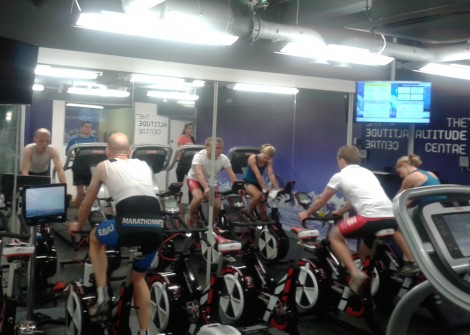I didn’t know it at the time, but I broke my hip on the final day of the 2013 Absa Cape Epic, one kilometre from the finish in Lourensford. Needless to say, that has resulted in my 2013 season being rather different than planned.
Far from coming off the Epic to start a brilliant European season of marathons, it’s now four months later and I haven’t yet been on a bike outdoors since that last km in late March. Rehab is the name of the game, not just to ride again, but actually just to be able to walk pain-free and without a limp.
However, I’m planning to get back to full strength, and have acquired an additional weapon in the armoury to do that: namely altitude training. If you’re Wiggins or Froome, you spend weeks at a time riding up and down Mount Teide in Tenerife, or if you’re Quintana you reportedly ride 20k up a mountain throughout your youth to get to school. And if you’re a Swiss marathon racer, you’ve got choice of many mountains to train on. However, those of us that work in offices hundreds of miles from the nearest mountain have to find other ways of going about things.
There are several different versions of altitude training: broadly speaking sleep high / train high, sleep low / train high, or sleep high / train low. And this can be achieved through a variety of bits of kit (if you haven’t got a mountain hotel close at hand): tents, masks, or permanent chambers, all hooked up to machines which pump in oxygen-depleted air. For instance, sea-level oxygen levels run at about 21% of the air by volume, whereas at 2,700m that is down to about 15%. Obviously these machines don’t replicate the lower pressure of altitude, but as far as training benefits go, they should do the trick.
I’ve had a go at sleep high / train low before, and came away with positive impressions on its effectiveness. But what I’m doing now is the reverse – train high / sleep low. Which as I understand it promotes a slightly different kind of physical adaptation: where sleeping high promotes the growth of red blood cells, akin to the effect of every 90s road pro’s favourite TLA (three-letter acronym), this is supposed to make the muscles more effective at hoovering up oxygen.
While I won’t try and attempt to paraphrase the science behind the effects of altitude, what is clear already is that it can certainly offer some benefits to someone recovering from injury. It’s possible to work the heart and lungs a lot harder than would be possible at sea level while still only placing a moderate strain on the affected joint or limb. This effect is apparently used by a number of Premier League footballers, for example.
I won’t pretend this is a scientific study – this is a sample of one, and a subjectively reported one at that. And (thankfully) I don’t have another experience of starting from square one fitness levels as a result of injury to compare it to.
What I can offer for now though is first impressions. The way that I can get access to altitude is via the Altitude Centre, based in the City in London, handily only half a mile from my office. Apart from anything else, it’s a very slick set-up. The chamber is in the same building as a smart gym, a running shop and a physio, and the facilities are very smart. Inside the chamber it just looks like a fairly traditional cardio fitness room – six bikes, four treadmills and two rowing machines. The only immediately obvious difference is a rushing noise from the machines pumping in the air. A closer look reveals that this is a place which is is serious about training though, as the bikes aren’t any old spinning bikes, but Wattbikes, as apparently used by the British track programme – not a bad pedigree. I’ll report back separately on my experience of them – overall they’re not without their flaws, but you can set them up pretty well to replicate your normal position, and you get that all-important power figure.
I’ve been doing a variety of sessions in there, from steady ones to more interval-based. What I find myself wishing is that I had a pre-injury baseline in the chamber to compare it to; as it is, all I can say is that it’s not very difficult at all to get the heart-rate really high when you’re being deprived of oxygen, and that fitness is returning pretty rapidly. I’ll be reporting back on progress once I’m further into the recovery process.
Have you had experience of training at altitude, either real or simulated, and what’s your experience? What other high-tech training tools have you used?

